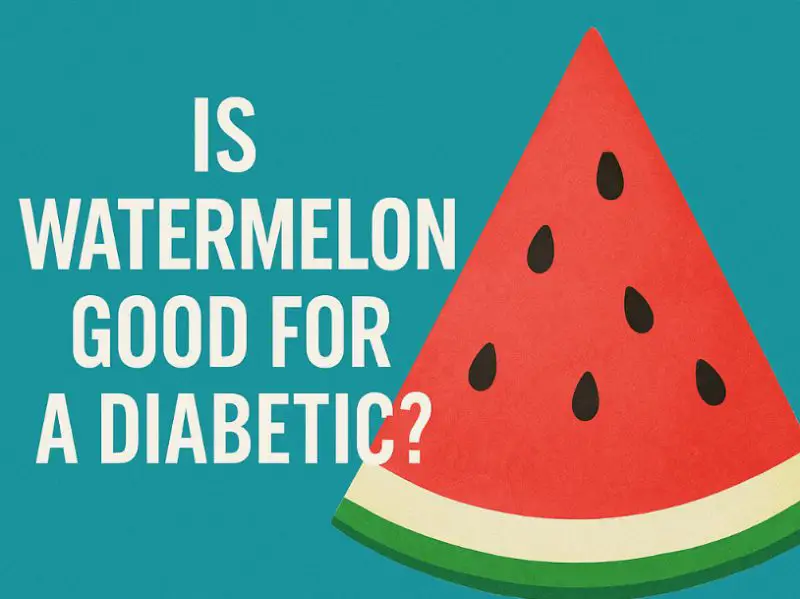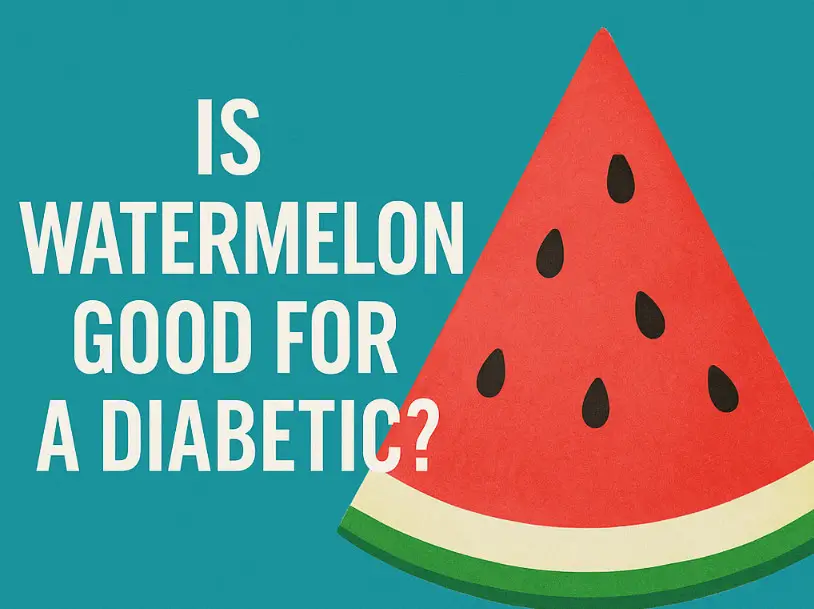If you’re living with diabetes and wondering whether you can enjoy a juicy slice of watermelon, you’re not alone. In this article we’ll dig deep into what research says about watermelon and diabetes, how this vibrant fruit affects blood sugar, and practical tips to include it safely in your diet. By the end, you’ll have a clear idea of when, how much, and how to eat watermelon if you have diabetes.
What is Watermelon? A quick overview

Watermelon is a refreshing summertime fruit, made up of about 90-95% water, naturally sweet, and enjoyed by many around the world.
Nutritionally, a typical one-cup serving (about 152 g) of diced watermelon contains roughly 11.5 g of carbohydrates and about 9.4 g of natural sugars.
Given this sugar content, you might guess that watermelon is off-limits for people with diabetes—but the reality is more nuanced.
Why People with Diabetes Worry About Fruit & Sugar
When you have diabetes, managing your blood glucose (blood sugar) is key. Carbohydrates—including natural sugars in fruit—can raise blood glucose after meals. Therefore, the concerns with watermelon for diabetics typically revolve around:
- The glycemic index (GI) of watermelon (how quickly its carbohydrates raise blood sugar in isolation)
- The glycemic load (GL) of typical serving sizes (how big the actual impact will be)
- Portion size, meal context, and what else you eat with the fruit
- Overall carbohydrate budgeting in a diabetic-friendly meal plan
So let’s examine how watermelon fares on those metrics.
Watermelon’s GI vs GL: What the numbers say
- Watermelon has a high glycemic index: about 72 (some sources report ~80) which is considered high.
- However, its glycemic load per typical serving is low: one source gives GL ~ 5 for a 120 g serving.
- Because watermelon is mostly water, its carbohydrate content per weight is relatively low, which reduces the actual glycemic load and thus the real‐world blood sugars spike.
What does this mean?
Even though watermelon’s GI is high (meaning theoretically it could raise blood sugar quickly if eaten alone in large amounts), the low carbohydrate amount per typical serving makes the actual blood sugar impact relatively modest. So it can be included — provided portion size and context are managed.
Nutritional Benefits of Watermelon That Matter for Diabetes
While the sugar content is important to monitor, watermelon brings several beneficial nutrients and health-supporting compounds, which make it a better option than many sugary snacks. Some of those benefits include:
- Rich in vitamin C and vitamin A (via beta-carotene) which support immune health and vision.
- Contains lycopene, a potent antioxidant associated with cardiovascular health, which is particularly relevant for people with diabetes (who have higher risk of heart disease).
- High water content (over 90%) means it can help with hydration and volume without excessive calories or carbohydrates.
- Some preliminary animal studies suggest watermelon juice may have hypoglycaemic (blood-sugar lowering) potential, possibly due to bioactive compounds protecting pancreatic cells.
Thus, from a nutrient viewpoint, watermelon is not “bad”—it offers value. The key is to include it in a way that’s mindful of blood sugar impact.
Is Watermelon Safe for People with Diabetes?
Short answer: Yes — in moderation and with appropriate portions and meal context. Many expert sources support this view.
- American Diabetes Association (ADA) says that whole fruit can fit into a diabetes‐friendly diet.
- Healthline notes people with diabetes can eat watermelon in moderation as part of a balanced diet.
- Medical News Today says it is safe for people with diabetes to eat watermelon in moderation, ideally alongside foods with fibre, protein or healthy fats to moderate the blood-sugar rise.
But: This does not mean unlimited consumption, nor does it mean any context is fine. The phrase “in moderation” means you need to integrate it into a meal plan where carbohydrate intake is controlled.
How Much Watermelon Can a Diabetic Eat?
While there is no one-size-fits-all universal serving, here are guidelines to help you estimate a safe amount:
- A frequently cited serving: about ½ to 1 cup of diced watermelon (≈ 75–152 g) is often considered safe for people with diabetes.
- Given the ADA guideline that a small piece of whole fruit or ½-1 cup of fruit counts as ~15 g of carbohydrates.
- As one example: one cup of diced watermelon has about 11–12 g of carbohydrates.
- Best practice: Include the watermelon as part of a meal or snack that has protein and/or healthy fat (nuts, seeds, yogurt, cheese) which slows absorption and stabilises blood sugar.
Practical tip: You might treat watermelon like “1 carbohydrate exchange” in your meal plan — count it into your total carbohydrate budget for that meal or snack.
When It Might Be a Problem
Even though watermelon can be included, there are situations when extra caution is warranted:
- If you eat a large slice (say half a whole watermelon wedge) you might get 20+ g of carb and 17-18 g of sugar which could raise blood sugar more prominently.
- Eating watermelon alone, on an empty stomach, may lead to a more rapid glucose rise, since there’s no fat/protein/fibre to slow absorption.
- If you drink watermelon juice (rather than eating the fruit), you lose the fibre and water bulk, making the sugar more concentrated and possibly raising blood sugar more.
- If your blood sugar is poorly controlled, or you have kidney issues (watermelon is high in water and some potassium), you’ll need to check with your healthcare provider.
- Late at night or as a snack when you won’t be active for a while – eating carbohydrate without upcoming activity may incline toward higher post-meal glucose levels.
How to Incorporate Watermelon in a Diabetes-Friendly Way
Here are practical strategies to enjoy watermelon while keeping your blood sugar stable:
- Control portion size: Measure ~½ to 1 cup of diced watermelon. Use a small bowl.
- Pair with protein or healthy fat: For example, ½ cup watermelon + handful of almonds, or watermelon + cottage cheese, or watermelon + plain yogurt. This helps slow digestion and absorption.
- Include in a balanced meal: Make watermelon part of your plate of non-starchy vegetables, lean protein, and a small portion of carbohydrate (including the watermelon).
- Mind the timing: Having watermelon earlier in the day (when you’re more active) may help rather than late night when you’re more sedentary.
- Avoid added sugars: Skip watermelon juice with added sugar or syrup. Fresh fruit is best.
- Monitor how your body reacts: Use your blood glucose meter to check how your levels respond after eating watermelon in your usual meal context.
- Mix with low-GI fruits and vegetables: If you want more fruit variety, include berries, apples, pears, which generally have lower GI/GL.
- Snack smart: Instead of candy or baked sweets, a small bowl of watermelon can satisfy sweet cravings with water and fibre, less calories and better nutrient profile.
A Closer Look: Research Highlights
- A 2016 study on rats found that watermelon juice showed protective effects on pancreatic cells and had hypoglycaemic potential.
- The weight of evidence suggests watermelon has no direct proof of “cures” or dramatic effect on diabetes, but it can support a diet that helps reduce complications (especially cardiovascular complications) thanks to lycopene and hydration.
- Research emphasises that the context matters more than the single food: what else you eat, your insulin or medication status, your overall diet pattern and physical activity.
Pros and Cons at a Glance
Pros:
- Nutrient-rich (vitamins A, C, lycopene, antioxidants)
- High water content → hydration, bulk, satiety
- Low glycemic load when portioned properly
- A sweet, fresh alternative to processed snacks
Cons:
- High GI → risk of blood sugar spike if eaten in large amounts or alone
- Contains natural sugar and carbs—needs to be counted in your meal plan
- Fruit juice form or large portions may worsen glucose control
- Not a substitute for other carbohydrate sources—you still need balance
Summary: Is Watermelon Good for a Diabetic?
The honest answer is: Yes — when eaten correctly and in moderation, watermelon can be part of a diabetes-friendly diet. It is not a forbidden fruit. But it is also not a “free” food that you can eat in unlimited quantities.
Here are the key takeaways:
- View watermelon as a carbohydrate food: count it in your daily carbohydrate targets.
- Portion control is crucial — think ½ to 1 cup diced as one serving.
- Pair it with protein or healthy fat, include it as part of a meal, and avoid large standalone servings.
- Monitor your blood sugar response when you eat it, especially if you are adjusting medication, physical activity or your diet.
- Use it as a refreshing, nutrient-rich alternative to high-sugar processed desserts or snacks.
- Continue focusing on the broader diet: vegetables, lean proteins, whole grains, healthy fats, regular physical activity — the single food will never make or break your diabetes management.
Frequently Asked Questions (FAQ)
Can I eat watermelon every day if I have diabetes?
Possibly yes, if the portion is small — about ½ cup — and it fits within your total carbohydrate budget for the day. Be sure to balance it with protein, healthy fat, and other nutrient-dense foods to help manage blood sugar levels. However, it’s best to rotate your fruit choices rather than eating watermelon every single day, to ensure a variety of nutrients and better glucose control.
Is watermelon better than other fruits for diabetes?
Not necessarily. Watermelon has its own advantages and disadvantages. For instance, berries tend to have a lower glycemic index and more fiber, making them easier to manage for many diabetics. However, watermelon provides excellent hydration, vitamin C, and antioxidants with relatively low carbohydrates when portioned correctly — making it a fine choice in moderation.
Should I avoid watermelon juice?
Yes. Watermelon juice removes most of the fiber and concentrates the sugar, which can cause a rapid rise in blood sugar levels. Fresh, whole watermelon is always the better option because it digests more slowly and provides fiber and nutrients that help moderate blood sugar response.
What about watermelon rind or seeds?
The rind and seeds aren’t usually part of a standard diabetic diet, but they aren’t harmful in small amounts. Focus on the red flesh, which provides the most nutrients and hydration benefits. If you enjoy the seeds or rind, you can include small portions after consulting with your dietitian, as they add minimal carbohydrates but may increase calorie intake slightly.
My blood sugar spiked after eating watermelon — what happened?
If your blood sugar increased sharply after eating watermelon, several factors might be involved. You may have eaten too large a portion, consumed it on an empty stomach, or skipped pairing it with protein or fat. Changes in your insulin dosage, medication timing, or physical activity can also play a role. Use your glucose meter to monitor your response, adjust your portion size, and consult your healthcare provider if spikes persist.
Final Thoughts
If you have diabetes and love watermelon, the good news is: you don’t necessarily need to skip it. With portion control, smart pairing with other nutrients, and attention to your meal plan, watermelon can be a refreshing, nutritious treat. The truth you should know is that context matters as much as the fruit itself. Including watermelon wisely is far better than avoiding all fruits out of fear. Work with your dietitian or diabetes educator, track your response, and make watermelon fit into your healthy plan—not disrupt it.
Disclaimer: This article is for educational purposes only and is not a substitute for professional medical advice. Always consult your doctor or a registered dietitian before making major dietary changes, especially if you have diabetes or any other chronic condition.



